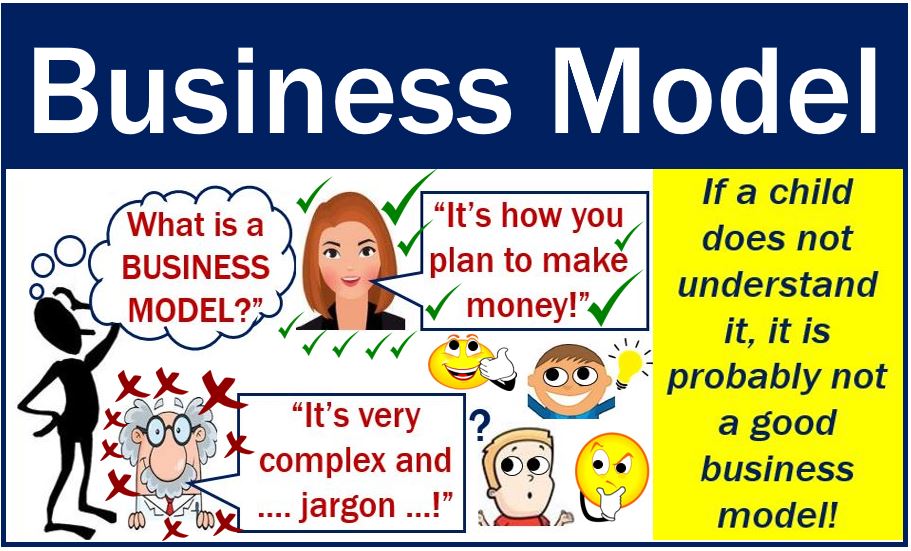Business model – definition and meaning
A Business Model is a company’s plan for making profits. It is an enterprise’s plan for its successful operations. A business model lists its sources of revenue, customer base, products, and financing details. The model describes how the company tries to capture value from its business. It also shows how it achieves this while delivering products and services to customers.
A business model will look at several aspects of a company, including how it makes its products and distributes them. It also includes information on pricing and advertising strategies.
The aim of every company is to thrive. In other words, businesses seek to generate greater revenue, make more profits and expand. The model is a plan on how the company can achieve this. It includes the components and functions of the business.

According to Cambridge Dictionaries Online, a business model is:
“A description of the different parts of a business or organization showing how they will work together successfully to make money.”
Business model includes functions
A business model contains all the functions of a business, including its revenues, expenses, corporate structure, and operating strategies. It also includes all sales and marketing procedures. In fact, the model contains anything that contributes to the day-to-day operations of the business.
The model has definitions of the responsibilities of the organization’s senior executives. In may also define all the departments and divisions in a company. Good business models describe people’s positions and job responsibilities.
Put simply; a business model explains how a company makes money. It may be quite simple and straightforward, or very complex. Above all, however, we should strive to make it as simple as possible.
Examples of a business model
The business model of a restaurant, for example, is an easy one to write. Restaurants make money by preparing meals and selling them to customers. The customers are hungry. In other words, the demand is hunger, and the restaurant supplies that hunger with food.
A website’s business model may not be so straightforward. The company may generate business in one of several ways.
Some websites offer a free service and make money from adverts that other companies place on its pages. A retailer, on the other hand, may have an online shop. In other words, it sells products online directly to the public.
Makers of printers sell cheap printers but expensive ink. In their business model, their initial product makes no money, but their follow-up goods are extremely profitable.
Several businesses sell a product very cheaply and then add-on consumables at high prices. Examples include makers of shaving razors and blades.
Gillette, for example, sells the razor at a low price, and then expensive replacement blades.
Similarly, video game console manufacturers often sell their hardware at a low margin or a loss, with the intent to profit from the sales of games and online subscription services.
Mobile phone companies start off by selling you a cheap handset. They subsequently sign up subscribers to buy calls over a 1-year period.
Dot.com bubble and business model craze
Financial journalist Michael Monroe Lewis, once said of the business model: “All it really meant was how you planned to make money.”
The ‘business model’ was one of the great buzzwords during the Dot.com Boom at the turn of the millennium. It was invoked “to glorify all manner of half-baked plans,” Mr. Lewis said.
During the Dot-com Boom, companies did not need a strategy or any special competence. In fact, they did not even need customers. All they needed was an online model that promised incredible profits at some vague, distant future.
Millions of people, executives, entrepreneurs, and investors fell for the fantasy. They subsequently lost a lot of money.
However, the aftermath of the Dot.com Bubble also led to a more cautious and value-driven approach in evaluating business models, emphasizing sustainable revenue and realistic market potential.
When the Dot.com Bubble burst, the concept of the ‘business model’ rapidly fell out of fashion.
Compound phrases with ‘business model’
In business English, there are many compound phrases containing the term ‘business model.’ Let’s have a look at some of them:
-
Business Model Innovation
Redefining or updating a company’s approach to creating and capturing value. As in:
“The company achieved business model innovation by shifting from traditional sales to a subscription-based service, thereby generating more consistent revenue.”
-
Business Model Canvas
A strategic management template for developing new or documenting existing business models. For example:
“Startups often use the Business Model Canvas to outline their value proposition, customer segments, and revenue streams in a concise and structured way.”
-
Digital Business Model
A model that primarily uses digital technologies and channels for business. For instance:
“Netflix’s digital business model disrupted the traditional movie rental industry by offering streaming services over the internet.”
-
Sustainable Business Model
A business approach focusing on long-term environmental and social sustainability. As in:
“Patagonia’s sustainable business model includes using recycled materials and donating a portion of its profits to environmental causes.”
-
Flexible Business Model
A business strategy designed to quickly adapt to market changes and customer needs. For example:
“During the pandemic, many restaurants adopted a flexible business model by adding online ordering and home delivery services to their operations.”
Video – What is a Business Model?
This educational video, from our sister channel on YouTube – Marketing Business Network, explains what ‘Business Model’ means using simple and easy-to-understand language and examples.

